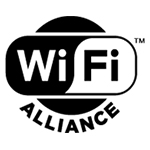 Devices designed to meet the 802.11ad standard can now get 802.11 WiGig certification from Wi-Fi Alliance. The 802.11ad WiGig standard aims to bring lower latency and multi-gigabit speeds to WiFi over distances of up to 10 meters (33 feet). The Wi-Fi Alliance program aims to ensure the interoperability of certified devices.
Devices designed to meet the 802.11ad standard can now get 802.11 WiGig certification from Wi-Fi Alliance. The 802.11ad WiGig standard aims to bring lower latency and multi-gigabit speeds to WiFi over distances of up to 10 meters (33 feet). The Wi-Fi Alliance program aims to ensure the interoperability of certified devices.
WiGig achieves higher speeds by making use of less congested, higher frequency 60 GHz spectrum and will complement earlier versions of WiFi operating at 2.4 GHz and 5 GHZ, Wi-Fi Alliance says.
The gigabit Wi-Fi technical spec is seen as key to fostering further development and commercialization of a new generation of 5G and other broadband wireless applications, such as augmented/virtual reality (AR/VR), multimedia streaming, gaming and others.
“Wi-Fi has delighted users for more than 15 years, and WiGig now gives users even higher performance in a rich variety of applications unleashing an unparalleled Wi-Fi experience,” Wi-Fi Alliance president and CEO Edgar Figueroa said. “WiGig further expands the Wi-Fi CERTIFIED portfolio into 60 GHz, and will augment existing and developing Wi-Fi programs and technologies. “
WiGig Certification
Wider 60 GHz channels enable WiGig devices to transport digital signals at rates as high as 8 Gbps, according to a Wi-Fi Alliance press release. In addition, ¨beamforming,¨ which focuses and directs signals among devices, eliminates interference from nearby devices and enables high performance even in dense signal environments, Wi-Fi Alliance says.
Wi-Fi Alliance has been at the forefront of industry efforts to develop a new generation of gigabit wireless broadband technology. Branching out to make use of new frequency bands is part and parcel of these initiatives.
“Wi-Fi Alliance certification has a strong history of accelerating broad technology adoption across the industry, and we expect 2017 to be a breakout year for WiGig on the heels of Wi-Fi CERTIFIED program availability,” commented ABI Research Director Phil Solis.
“The ecosystem for WiGig spans the mobile, PC, and consumer electronics industries across the consumer, enterprise, and service provider markets. Devices will leverage the brand and ubiquity of Wi-Fi for continued momentum across these industries.”
ABI Research forecasts some 180 million smartphone WiGig chipsets will be shipped worldwide in 2017 and account for nearly half the total market of 1.5 billion in 2021.


